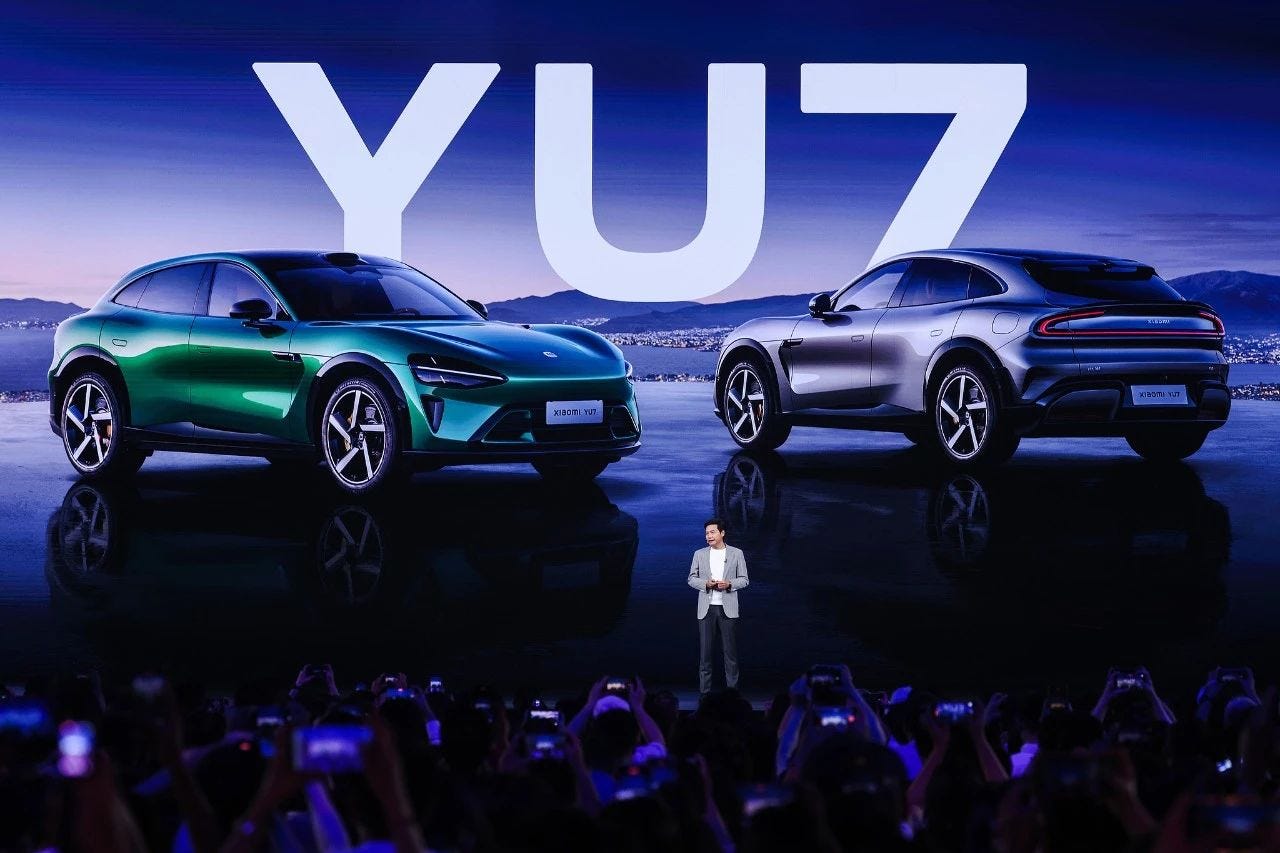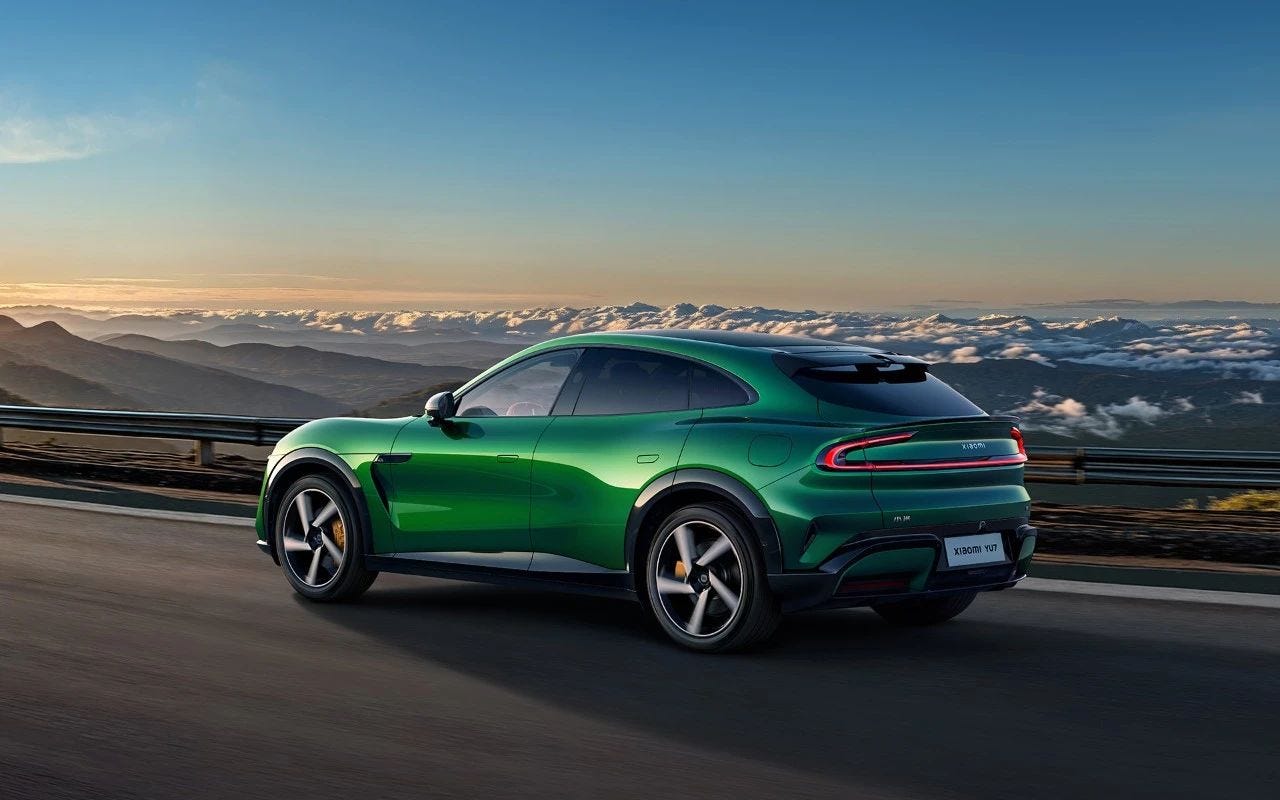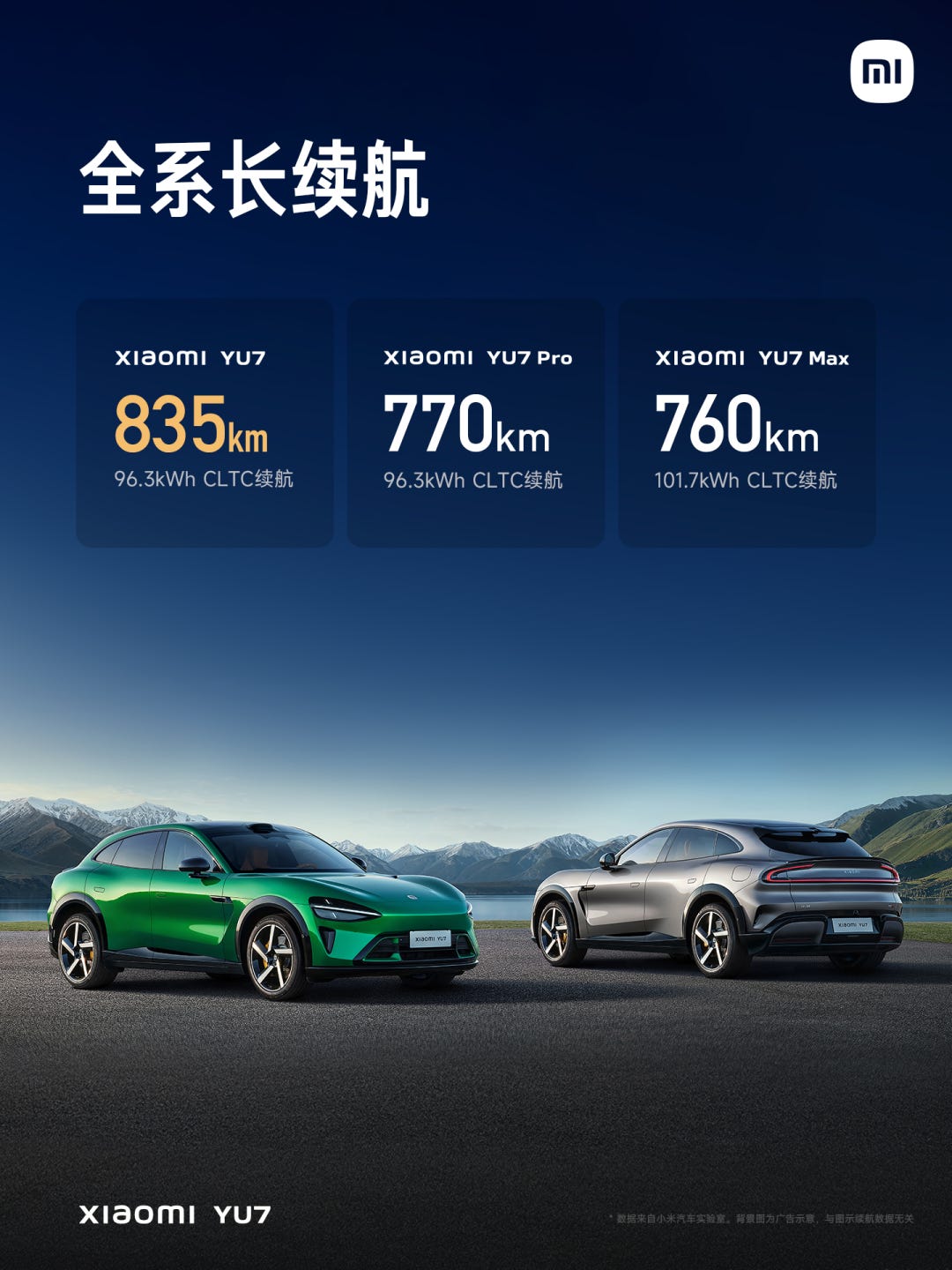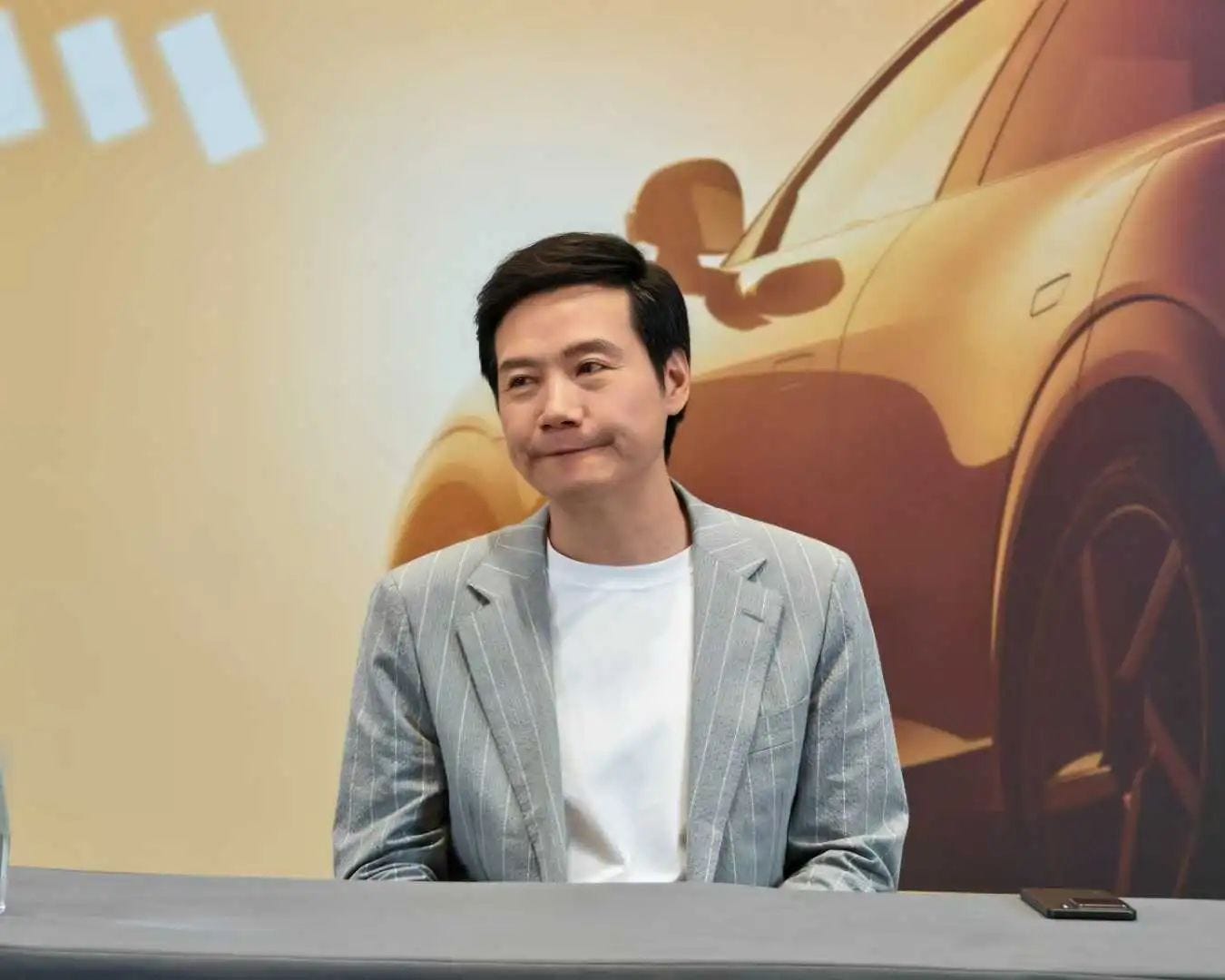Xiaomi's High-Stakes Gamble
Can a smartphone playbook build a great car? Fresh off its hyped SU7 debut, Xiaomi doubles down with a luxury SUV—and faces a brutal reality check.
Introduction: An Industrial Miracle
On June 26, 2025, China's tech industry witnessed a moment of near-miraculous market frenzy. Xiaomi, a company globally renowned for its smartphones, launched its first-ever SUV, the Xiaomi YU7. Within a single hour of the launch event concluding, its "firm orders" (requiring a ~US$700 refundable deposit) surged past 289,000 units.
But an even more persuasive statistic emerged in the days that followed: according to industry key opinion leaders (KOLs), a remarkable 280,000 of those initial orders were ultimately "locked-in," meaning buyers waived their 7-day right to a refund. This staggering conversion rate of over 90% signals something far beyond mere fan enthusiasm. It raises a more profound question: What deep-seated consumer demand did Xiaomi tap into to create such an unprecedented miracle of market trust?
This market euphoria unfolded against a delicate backdrop. Just months earlier, Xiaomi's debut vehicle, the SU7 sedan, had been embroiled in a public controversy following an accident involving its advanced driver-assistance system. Consequently, the YU7's launch was seen as a critical test of the brand's resilience and crisis management. This article will dissect Xiaomi's car-making logic, the unique challenges it faces, and the insights this high-stakes crossover holds for the global tech and auto industries.
Lei Jun's Logic: The "Experience-First" Crossover Playbook
To understand why the YU7 ignited the market, one must first understand the unique product philosophy its founder, Lei Jun, has imported from the world of consumer electronics. His core concept can be summarized as "master the essentials, then innovate" (守正出奇)—respecting the fundamental laws of the auto industry ("the essentials") while redefining the user experience with an internet and consumer-tech mindset ("the innovation").
In China's hyper-competitive ~$35k-$48k price segment, where competitors often engage in an arms race of specifications, Lei Jun's launch presentation notably prioritized design and "emotional value" over raw performance metrics. He spent considerable time detailing thoughtful touches, such as a rare zero-gravity seat for the driver and a makeup mirror for the front passenger with three adjustable color temperatures. This obsessive focus on nuanced user experience is highly reminiscent of Apple's product philosophy.
On the technology front, Xiaomi's approach is to leverage its dominance in one field to disrupt another by applying superior tech to a traditional industry. It uses a flagship smartphone chip (the Snapdragon 8 Gen 3) to power its in-car system for maximum fluidity, introduced an innovative "Sky Screen" panoramic display, and equipped all trims with a high-end ADAS suite featuring LiDAR and NVIDIA's Thor chip. This is backed by Lei Jun's "10x investment" doctrine—using a budget and engineering team far exceeding industry norms to compensate for a lack of experience.
Ultimately, all these features serve Xiaomi's "Human × Car × Home" ecosystem strategy. Through cleverly placed magnetic mounts and power ports, the YU7 is designed to seamlessly integrate with other Xiaomi devices, transforming the vehicle into an infinitely expandable smart space—which is precisely the moat Xiaomi aims to build beyond the car itself.
Collision with Reality: When "Hype" Meets "Capacity"
The spectacular success of the YU7 launch put Xiaomi and Lei Jun in the spotlight. But beyond the glare, the automotive newcomer faces a series of hardcore challenges.
First is the persistent test of safety and trust. Although Lei Jun dedicated a significant portion of the YU7 launch to emphasizing its safety features (like its "armor cage" body and extensive road testing), this was a clear response to the immense pressure from the prior SU7 incident. For a product where lives are at stake, any single safety failure can be fatal to a new brand. Xiaomi must continuously prove it can manage the auto industry's highest priority.
Second is the unavoidable trial of "manufacturing hell". This is Xiaomi's most immediate and severe challenge. The 280,000 locked-in orders stand against a combined annual production capacity for its two factories of roughly 300,000 to 450,000 units. A massive order book is a blessing, but if high-quality deliveries can't be made within a reasonable timeframe, that blessing can quickly curdle into customer complaints and brand damage. This situation is highly reminiscent of the "production hell" Tesla famously endured with the Model 3.
Finally, there is the "hell mode" market competition. The YU7 has entered one of the most fiercely contested market segments in the world. It must go head-to-head not only with the global segment leader, the Tesla Model Y, but also with formidable local competitors like Huawei's AITO and Li Auto, brands that have already established strong product definitions and user loyalty. The hand-to-hand combat in the market has already begun.
Lei Jun's Post-Launch Reflection: Staying Sober Amidst the Frenzy
In an in-depth interview following the frenzied YU7 launch, Lei Jun offered a valuable window into his thinking and shifting mindset under immense pressure.
Responding to the common narrative that "Xiaomi wins through marketing," he appeared both weary and firm. He pushed back, emphasizing that outsiders may underestimate Xiaomi's deep experience in manufacturing. "After all, we've been in the manufacturing industry for so many years," he stated, referencing their advanced, self-developed smartphone factory. He argued that sustained success depends on "building capabilities and having no weak points."
The launch's massive success also forced a profound change in Lei Jun's self-perception. He confessed that he initially viewed Xiaomi Auto as a "first-year student" that deserved some leniency from the industry. However, the market and competitor reactions made him realize that the world already sees Xiaomi as a major, heavyweight player. "We used to think of ourselves as newcomers, and I think our standards weren't high enough," he said. "Today, we must see ourselves as a key enterprise in the auto industry... we must be cautious in our words and actions, because any flaw can be amplified."
This shift in tone, from a self-proclaimed 'new student' to a self-aware 'major player,' marks a crucial maturation for a company whose public image has, until now, been largely defined by its founder's charismatic and often aggressive marketing style.
When discussing competition, Lei Jun projected a mature entrepreneurial mindset. On one hand, he emphasized the need to "dare to draw the sword" and compete head-on with top global products like the Tesla Model Y. On the other, he showed deep respect for his rival: "The Model Y is an excellent product. Its status as a global bestseller is absolutely not just because of Elon Musk's brand effect; there are many things to learn... we must learn from them humbly."
Conclusion: The Future of a High-Stakes Gamble
Xiaomi's "internet playbook" for cars, validated by the YU7's stunning market reception and high lock-in rate, has achieved immense initial success. It has accurately identified and amplified a shift in the consumer market, where a younger demographic, less bound by traditional automotive hierarchies, increasingly values personalization and "emotional value." The YU7's seemingly "inefficient but beautiful" long-hood design and its superlative tech experience are perfectly tailored to this new demand.
However, it is far too early to declare that this high-stakes gamble has paid off. Applying its smartphone playbook to the automotive world presents a clear set of trade-offs. The advantages are its unparalleled marketing reach, a deep understanding of user experience (UX) software, and a rapid iteration product development mindset. The challenges, however, are its potential underestimation of the long-term complexities of hardware manufacturing and safety engineering, supply chain management on a completely different scale, and the necessity of providing high-quality, long-term service for a high-value durable good.
For existing players in the global auto industry, Xiaomi's entry is a powerful signal: a new breed of competitor, armed with a user-experience-centric playbook, is arriving from the tech world with the potential to disrupt from a different dimension.
For investors and market observers, evaluating Xiaomi Auto's long-term value requires looking beyond the initial order frenzy. The metrics that will truly matter are sustained delivery volumes, real-world user satisfaction, stable gross profit margins, and actual progress in core technologies like autonomous driving.
Ultimately, Xiaomi's success or failure will provide an invaluable blueprint of opportunities and pitfalls for all global tech giants attempting to cross over from the worlds of software and consumer electronics into the demanding realm of heavy industry.








